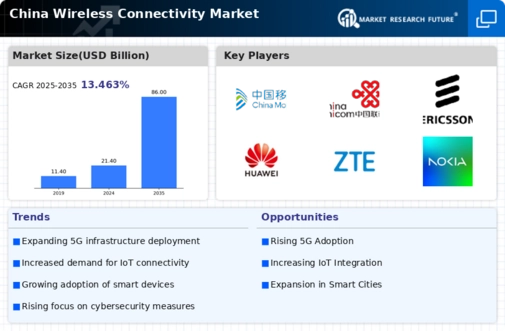Growth of Smart Cities
The concept of smart cities is gaining traction in China, significantly impacting the wireless connectivity market. As urban areas evolve into smart cities, the demand for interconnected devices and systems increases. This transformation necessitates robust wireless networks to support applications such as smart transportation, energy management, and public safety. By 2025, it is projected that over 200 cities in China will implement smart city initiatives, driving the need for enhanced wireless connectivity. The wireless connectivity market is likely to thrive as municipalities invest in infrastructure to support these advancements, creating a more integrated urban environment.
Emergence of New Technologies
The wireless connectivity market in China is witnessing the emergence of new technologies that are reshaping the landscape. Innovations such as Wi-Fi 6 and Li-Fi are gaining traction, offering faster and more efficient data transmission. These technologies are particularly relevant in densely populated urban areas where traditional networks may struggle to meet demand. As businesses and consumers seek improved connectivity solutions, the wireless connectivity market is likely to benefit from the adoption of these advanced technologies. The potential for enhanced user experiences and increased network capacity may drive further investments in infrastructure and service development.
Increased Mobile Device Penetration
The proliferation of mobile devices in China is a critical driver of the wireless connectivity market. With over 1.5 billion mobile subscriptions reported in 2025, the demand for mobile internet access continues to rise. Consumers increasingly rely on smartphones and tablets for various activities, including social media, e-commerce, and online education. This trend compels service providers to enhance their network capabilities to accommodate the growing user base. The wireless connectivity market is thus positioned to expand as mobile data consumption increases, necessitating improvements in network infrastructure and service offerings.
Rising Demand for High-Speed Internet
The wireless connectivity market in China experiences a notable surge in demand for high-speed internet services. As urbanization accelerates, more individuals and businesses seek reliable and fast internet connections. This trend is evidenced by the increasing number of broadband subscriptions, which reached approximately 500 million in 2025. The growing reliance on digital services, including streaming and online gaming, further propels this demand. Consequently, telecommunications companies are investing heavily in infrastructure upgrades to enhance service quality. The wireless connectivity market is thus positioned to benefit from this rising demand, as consumers expect seamless connectivity and higher data transfer rates.
Government Initiatives and Investments
The Chinese government plays a pivotal role in shaping the wireless connectivity market through various initiatives and investments. Policies aimed at promoting digital transformation and enhancing connectivity infrastructure are being implemented. For instance, the government allocated over $100 billion for the development of 5G networks and related technologies. This investment is expected to bolster the wireless connectivity market by facilitating the deployment of advanced communication technologies. Furthermore, government support for research and development in wireless technologies encourages innovation, which may lead to new applications and services, thereby expanding market opportunities.

























Leave a Comment